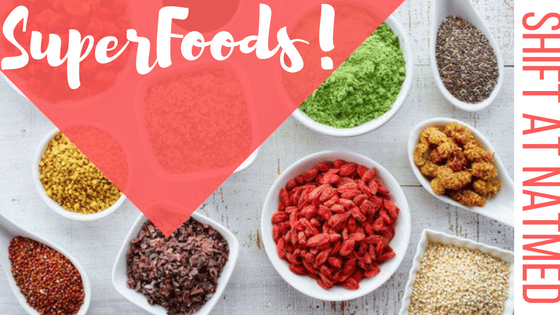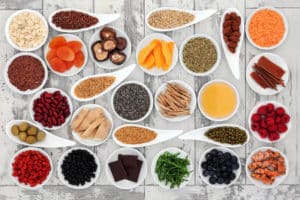
13 Aug Superfoods
SHIFT Superfoods!
Superfoods are foods that are more nutritionally superior – more bang for your buck!
These foods are considered Superfoods due to their high content of health-promoting substances.
Including anti-oxidants such as:
- Vitamin A
- Vitamin C
- Vitamin E
- Bioflavonoids: which strengthen the cardiovascular system and protect against free radical damage.
‘Free radicals are substances that breakdown and damage your DNA which can turn a healthy cell into a cancerous cell. They create inflammation in the body causing pain, arthritis, heart disease and wrinkles.’
These foods also contain a high amount of fibre which helps to keep you regular and promotes a sense of fullness following meals which helps when trying to reduce your food intake. They all have a negligible effect on your blood sugar levels which helps to sustain your energy levels throughout the day.
As a general rule, the deeper the red, purple or green colour of your fruits and veggies, the higher the concentrations of antioxidants and health-promoting phytonutrients.
By eating the following superfoods on a regular basis you are giving your body the best defence against disease and ageing. The Shift program recipes are designed to include as many of these superfoods as possible. This means that the Shift program is not only a great weight loss program, it is also a fantastic program for achieving the best results for longevity and health or vitality.

1. Alfalfa sprouts
Alfalfa in Arabic means “father of all foods”. The plant has a tap root, up to 15 feet in length with which it draws its bounty of nutrients. High in most nutrients especially Vit B, C, D and E and very low in fat. Alfalfa also contains phytoestrogens which are useful for menopausal women in easing symptoms and supporting bone health. They are a natural diuretic helping to ease water retention. Alfalfa alkalinises and detoxifies the body, especially the liver.
2. Almonds
High in monounsaturated fats, the same found in olive oil, almonds are particularly beneficial for those with heart disease and high cholesterol. Also high in Vit E and contain more protein, weight for weight than the mighty egg. In addition to this, a quarter of a cup (30-40gms) of almonds will give you 100 mg of magnesium and a good dose of calcium and potassium. No longer the dieter’s foe, a recent study indicated that regular nut eaters often maintain a healthy weight. Due to the high levels of protein found in almonds, they have a blood sugar lowering effect if eaten with a high GL meal.
When buying almonds and nuts, in general, your best bet is to buy them in their shells. Nuts, when exposed to light and air go rancid very quickly. If buying from bulk bins, ensure that the shop has a quick turnover of product and always smell them first. They should smell sweet and nutty, not bitter or sharp. Do limit yourself to a handful every second day.
3. Apples
A member of the rose family, we have said for years that an apple a day keeps the doctor away. They have a wonderful effect on balancing blood sugar levels, particularly mid-morning and afternoon and this is mostly due to its high fibre content. The high levels of pectin help in lowering cholesterol and keeping you regular.
Look for hard apples and if you can dent it then it is overripe and needs to be stored in the fridge. Unfortunately, apples are prone to disease and are quite heavily sprayed so do wash your apples thoroughly. Red apples contain higher levels of anti-oxidants. Thinly sliced apple and pear can be used as cracker substitutes when eating cheese.
4. Avocado
Avocadoes are rich, creamy and filling and like almonds are often shunned for being fattening. Recognised as a complete food, even used in South America to wean babies, avocados are high in potassium and Vitamin A and have moderate amounts of Vit C, E and B6. High in monounsaturated oil, avocado’s help lower your “bad” LDL cholesterol. A quarter of a medium avocado will give you approximately 7 grams of fat and you should aim to limit your fat intake to 40 grams per day.
Unlike other fruit, avocado’s start to ripen as soon as it is picked from the tree. Buy them firm and green and ripen in a brown paper bag with an apple or ripe banana. Keep refrigerated only if you wish to slow the ripening process.
Slice it, mash it, dice it and eat it!
5. Beans (Including cannellini or navy, soy, chickpeas, and those found in 4 bean mix)
Beans peas and lentils are all legumes meaning that they are plants with a seed pod that splits in half. Beans are low in fat, are an excellent source of non-animal protein and are pack with essential nutrients and fibre. They are also rich in compounds that have shown promise in the prevention of a number of cancers. Having a low Glycaemic load, they keep blood sugar levels balanced which contributes to more balanced energy and reduced cravings for sugar. Cannellini beans are good for women with low iron as 1 cup will give you a quarter of your daily iron needs.
Legumes form a large part of traditional diets throughout the world but are sadly lacking from the western diet. They are a great substitute for higher glycaemic foods including white rice, and potatoes, which may go a long way in preventing type II diabetes. They also play a significant role in abating hunger. The consumption of beans has also shown to improve cardiovascular health. The soluble fibre reduces cholesterol, the folate reduces homocysteine levels in the blood. Homocysteine is related to high cardiovascular disease risk. High levels of magnesium and potassium found in beans help to lower blood pressure. You are recommended to have 3 cups of legumes per week, but not during the Quick Shift as legumes are higher in sugars than other proteins.
6. Beetroot
Like most vegetables, beetroots are low in fat, nutrient-dense and very low in calories. Because of their deep red colour, we know that they are high in bioflavonoids, carotenoids and have been used for centuries throughout Europe as an anti-cancer treatment. The green leafy part of the beetroot is also very high in anti-oxidants and is tasty steamed. Canned beetroot often has added sugar and salt so do read the label. Best to grow your own or to use fresh, grated in a salad. When buying beetroot, look for the beets with fresh stems and preferably leaves. Cook with a little of the stem left on so not to waste valuable nutrients.
7. Berries
Scientists have recently discovered that berries have some of the highest antioxidant values of any fruit or vegetable which helps us to combat specific cancers, whilst supporting healthy urinary tract function, memory capacity and healthy ageing.
By including berries with your protein smoothie, you not only get an antioxidant boost but also a delicious tasting and convenient breakfast alternative.
Frozen berries will give you the same benefit as fresh and are available all year round.
Use them any time as a snack with natural yoghurt or cottage cheese.
8. Bok Choy
A type of Chinese cabbage and another member of the mighty cruciferous family of vegetables. Dark green leaves and juicy stems provide you with a tasty alternative which marries well with stir fry and seafood dishes. Packed with Vitamin A, B, C and Calcium plus contains a large amount of water so for next to no calories bok choy is rather filling.
Great as a side dish, lightly steamed with a little soy sauce. Goes very nicely with tofu.
9. Brazil Nuts
These nuts are extremely nutrient-rich containing high amounts of Selenium, a powerful antioxidant, niacin, magnesium, vitamin E, protein, fibre, but like all nuts are also quite high in fat. Limit your total nut intake to a small handful daily.
10. Broccoli
Possibly the most nutritious vegetable on the planet. Gram for gram, broccoli has more vitamin C than an orange and as much calcium as a glass of milk. One medium spear of broccoli has three times the amount of fibre than a slice of wholemeal bread. The brassica family (cabbage, cauliflower, Bok Choy and broccoli) contain chemicals known to stimulate the body’s production of its own cancer-fighting substances.
In order to maximise the release of the sulphur compounds responsible for most of the benefits, it is important to slice or cut the vegetables and allow a few minutes to pass before cooking. In order to gain the maximum benefit from your cruciferous veggies cut them and allow them to sit for a few minutes allowing their enzymes to go to work releasing their sulphur-containing nutrients. Enjoy it every day either steamed or lightly blanched.
These are just TEN of the many superfoods recommended by the SHIFT diet program we provide at NatMed, if you are looking to enrich your diet, to lose weight, to maintain your weight, or simply to feel your best –
